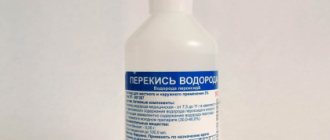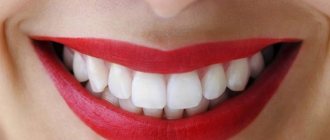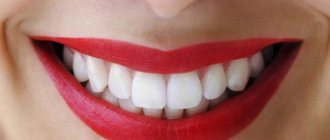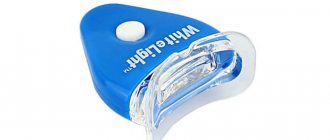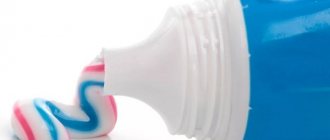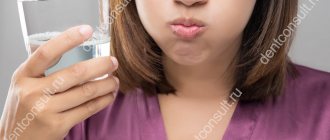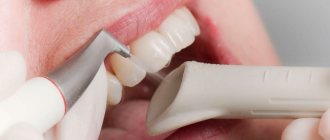1451
The desire to have a beautiful smile that reveals even, snow-white teeth is completely natural.
However, insufficient hygiene procedures, incorrectly selected oral care products, as well as many other factors lead to the fact that the enamel - the protective shell of the teeth - darkens or acquires a yellowish-brown tint over time.
One of the most popular substances for lightening tooth enamel is considered to be ordinary baking soda, which is used both independently and in combination with other components.
How does baking soda affect teeth?
Soda is a good and inexpensive disinfectant. Even now, doctors recommend using it in dental treatment of infants who are diagnosed with stomatitis or oral thrush.
Soda kills fungus and promotes rapid healing of ulcers on the mucous membrane that appear as a result of stomatitis due to its high regenerative properties. In addition, sodium bicarbonate has a pronounced anti-inflammatory effect. Dentists often prescribe rinses or baths with soda or soda-saline solution for purulent periodontitis and pulpitis, after opening the cavity of the affected tooth.
In America, clinical observations of the oral health of patients using soda pastes for brushing their teeth and microbiological analyzes of the contents from the oral cavity of these patients showed that the concentration of pathogenic microorganisms is significantly reduced.
Whitening effect of brushing teeth with baking soda
As for hard tooth tissues, soda has a good whitening effect . The enamel is lightened by at least 0.5 shades, which can be compared with professional oral hygiene. This happens thanks to abrasive particles that efficiently clean the tooth surface from dental plaque and food debris. Conventionally, you can compare brushing your teeth with soda to cleaning various surfaces with sandpaper.
American scientists even conducted a study in 2008 that showed that pastes based on baking soda are much better at removing dental plaque than pastes with a soda-free composition or a low concentration.
It is necessary to take into account the fact that soda is a pure abrasive. Abrasive particles are found in many toothpastes, especially whitening ones. Dentists do not recommend using whitening toothpastes for longer than 2 weeks, because... abrasive particles can thin the enamel layer of the tooth, leading to hypersensitivity. For this reason, pure abrasive in the form of baking soda definitely cannot be used often . Dentists also do not recommend using soda in dry, undiluted form.
You also need to pay attention to the pH of the soda. It is equal to 8, which is typical for an alkaline environment. Many people are afraid of this indicator, but it is only dangerous for the protective barrier of the skin, which is manifested by redness around the mouth if soda pastes act on the skin for a long time. For the oral cavity, an alkaline environment, on the contrary, is positive, because it neutralizes acidity. It is high acidity that contributes to the destruction of hydroxyapatites in the enamel, which act as a kind of skeleton, thereby disrupting the structure of hard tissues and provoking the development of caries and its complications in the future.
Soda teeth whitening:
The benefits and harms of cleaning
Only baking soda is suitable for teeth!
The advantages of sodium bicarbonate pastes include:
- Achieving a positive result quickly, the enamel becomes lighter after the first procedure.
- Easy to prepare pasta and use it.
- Removal of all dental plaque.
- Low cost.
- Relief of unpleasant odor from the oral cavity.
- Relief of inflammatory processes in the oral cavity.
- Accelerated healing of wounds in the mouth.
- Neutralization of acidity in the mouth.
- Destruction of pathogenic microorganisms and fungi of the genus Candida that cause candidiasis (thrush).
There are also disadvantages :
- High abrasive properties. Frequent use of soda contributes to the thinning of the enamel layer and the development of the carious process in the future.
- Irritating effect on soft tissues in the form of red spots or rashes around the mouth.
- Risk of developing bleeding gums.
- The appearance of sensitivity to hot, cold and sour with frequent use of the soda bleaching procedure.
- The short duration of the achieved result.
Important! To prevent the development of these shortcomings, it is not recommended to use products with sodium bicarbonate more than once every 3-4 weeks.
How does it affect enamel?
Baking soda or sodium bicarbonate is a slightly alkaline compound. Physically, it appears as small white crystals. The use of this substance for whitening tooth enamel is based on its abrasive and disinfectant properties.
First of all, soda removes even hard plaque, completely cleansing the enamel . This is what gives the whitening effect.
In addition, after using it, most of the bacteria that are involved in creating plaque are destroyed in the oral cavity.
However, at the same time, as a strong abrasive, soda removes not only surface deposits, but also particles of enamel, which can lead to thinning and hypersensitivity of teeth.
Indications for using soda
Soda must be used when the enamel darkens due to plaque formation
The main indication for using soda pastes when brushing teeth is darkening of the enamel.
The following factors contribute to darkening:
- Consumption of foods and drinks with food colorings.
- Smoking.
- Age.
- Poor oral hygiene.
Baking soda can combat these reasons.
But there are reasons that can only be eliminated by professional, internal tooth whitening. These include:
- Tooth injury.
- Consequences of endodontic treatment.
- Taking certain medications.
- Genetics.
In these cases, the darkening of the enamel begins from the inside, and superficial whitening methods will not give even minimal results.
Video experiment to identify the effect of soda and salt on teeth:
Whitening procedure
A few days before whitening, it is recommended to prepare your teeth for it. To do this you should:
- Make sure that your diet includes a sufficient amount of foods containing calcium, phosphorus and fluorine (dairy and fermented milk, cereals, seafood, vegetables, herbs). The presence of these elements will help strengthen dental tissues. Then the risk of cracks in the enamel will be minimal.
- Take vitamins or vitamin complexes to strengthen teeth enamel. Their specific composition should be discussed with a specialist. It is recommended to begin the whitening procedure after completing the “dental” diet. These ingredients can be used together or separately.
Attention! Only baking soda is used to whiten teeth. Using soda ash is very dangerous!
Soda + lemon. This option looks like this:
- pour 1 tsp into a bowl. soda;
- add 1 tbsp here. lemon juice until a paste-like mass forms.
You should carefully clean the surfaces of your teeth with this paste, placing it either on a toothbrush or in a bandage swab. After cleaning, rinse your mouth well.
The first use of this composition usually gives results. To consolidate it, it is recommended to limit the consumption of coloring products.
Soda. It can be used as a bleaching agent and separately. The options could be:
- Instead of tooth powder. Gently move the brush along with baking soda over the tooth surfaces for 2-3 minutes. Then the mouth is washed with water.
- Like a mouthwash. First, prepare a saturated soda solution: gradually add portions of soda to half a glass of warm water. When its dissolution begins to decrease, you can begin rinsing the mouth. It is carried out after finishing regular teeth cleaning.
Lemon. Separately, this fruit can also serve as a quick whitening agent. You can use it like this:
- Use a piece of lemon zest to wipe your teeth with the inner (white) side.
- Freshly squeezed lemon juice is dripped onto your toothbrush (or added to toothpaste) and brushed as usual.
Rules of application
To achieve white teeth without damaging the enamel layer of the tooth, you need to use sodium bicarbonate a maximum of once a month. In this case, you need to use it mixed with water, the consistency should be mushy. You can use any other solvent.
Attention! Do not use dry soda under any circumstances; it can leave scratches on the enamel layer.
This is what the paste should look like
In addition, dry soda powder feels like sand in the mouth, which causes discomfort. It is better to use the product in diluted form, mixing it with toothpaste or other substance.
There are several proven recipes for preparing homemade soda pastes and solutions, which will be discussed below.
The method of brushing your teeth can be standard, but it is better to use circular movements of the brush. This will not only clean the tooth surfaces, but also massage the gums, improving tissue trophism.
Is it possible to brush your teeth with baking soda every day?
Dentists have a negative attitude towards any abrasive products, therefore, from a professional point of view, daily brushing of teeth with soda is prohibited. It was already mentioned above that daily use leads to destructive processes in tooth tissue, but people still strive to achieve positive dynamics and consolidate this result for a long time.
Carefully! It is impossible to achieve a lasting result with whitening soda. Excessive efforts will lead to other dental problems that cannot be treated at home.
The effect after brushing teeth with soda does not last long, which explains the desire of patients to use this method of hygiene more often. However, daily use thins the enamel more and more. Dentin, which is much darker, begins to appear through the thin enamel layer.
As a result, the teeth become even darker than they were before and it will no longer be possible to achieve lightening at home. In addition, thin enamel easily allows waste products of pathogenic microflora, which are the source of the development of most dental diseases, to pass through it.
Dentist on brushing teeth with soda:
Is it possible to brush your child's teeth with baking soda?
It is better not to brush teeth with a milk bite with soda. There are several reasons for this:
- The enamel is already white and does not need bleaching.
- The enamel is not fully formed and is very porous, which can contribute to its rapid destruction.
Pros and cons of home teeth whitening
When compared to a professional procedure, home teeth whitening is cheaper and more accessible.
At the same time, folk remedies are ineffective and do not affect the color of the enamel, but only eliminate soft plaque. The result does not last long and there is a high risk of damaging the enamel.
In addition, teeth whitening according to traditional recipes can cause a number of side effects:
- Burns to the oral mucosa due to the use of hydrogen peroxide.
- Irritation of soft tissues located in the cervical part of the gums.
- Burning and tingling sensation in the gums.
- Increased sensitivity of teeth, reaction to cold and hot.
To avoid such effects, it is not recommended to whiten teeth at home without consulting a dentist.
How to brush your teeth with soda
Before you start brushing your teeth with soda, you need to be completely sure that:
- The enamel is of sufficient thickness.
- The enamel is free of microcracks.
- There is no hypersensitivity.
- Darkening of the enamel layer is not associated with genetic factors, injury or medications.
Personal hygiene products used to clean dental surfaces with soda pastes:
- A toothbrush with soft bristles (some dentists recommend not using a brush at all, but replacing it with a bandage, a cotton swab, or simply using your index finger to brush).
- Toothpaste (non-whitening), water, lemon juice or hydrogen peroxide.
Cleaning technique:
- Combine baking soda with one of the ingredients: water, toothpaste or lemon juice until it becomes mushy.
- Place the mixture on the head of your toothbrush.
- Clean dental surfaces using circular movements, without much force.
- Duration of cleaning is up to 3 minutes (if water or toothpaste is used as a solvent), no more than 1 minute (if the solvent is lemon juice or hydrogen peroxide).
- Rinse your mouth vigorously with running water or a mint or herbal mouthwash to remove the unpleasant aftertaste.
Recipe options
The most popular recipes using soda are:
| Soda with lemon juice | There are recipes for paste and solution. To prepare the paste, you need to combine a teaspoon of sodium bicarbonate with the juice squeezed from fresh lemon. Add juice drop by drop until a paste consistency is reached. The paste copes with plaque much better than the solution. The rinsing method lightens the enamel slightly. To do this, the juice of one lemon is mixed with a teaspoon of baking soda. |
| Soda with toothpaste | To prepare the composition, you need to use equal amounts of toothpaste and soda, and the toothpaste should contain fluorides, which strengthen the enamel, and potassium nitrate, which reduces sensitivity. |
| Baking soda and hydrogen peroxide | To prepare the paste, you need to take 1 teaspoon of baking soda and ½ teaspoon of peroxide. |
Video about teeth whitening with baking soda and peroxide:
Homemade pastes with soda
- If there is a large amount of plaque covering more than half of the dental crowns, you can prepare a powerful paste. It consists of hydrogen peroxide, soda, salt and industrial toothpaste in equal parts.
Soda
Salt
Toothpaste
- If inflammation of the soft tissues of the oral cavity occurs frequently , you can use a homemade eucalyptus-based paste. The ingredients include warm olive oil (2 teaspoons), finely chopped and grated eucalyptus leaves (1 teaspoon), baking soda (1 teaspoon) and a teaspoon of fine salt.
Olive oil
Eucalyptus leaves Soda Salt
- If you are prone to developing tartar, you can prepare a paste with more aggressive abrasive particles. To prepare you will need 20 grams of soda, 45 grams of chalk, 50 grams of white clay and peppermint essential oil (10 drops).
Soda
Chalk
White clay
Peppermint essential oil
Do you want to whiten your teeth as easily as possible…….I advise: I tried it on myself!
Girls, I found some information on the Internet, which I duplicate in my diary, I really liked the recipe, it’s stunning. Nowadays, hundreds of toothpastes promise us a Hollywood smile in 5 minutes! The recipe is not mine, downloaded from the Internet by the author of the title sharm. thank you so much!!!!!!!!!! So the author writes, “you buy this vaunted (and expensive!) toothpaste... but the result is zero... and what’s remarkable is that each toothpaste is, as it were, “highly specialized”! For whitening, buy this one, for treatment, buy another, and for tartar, buy a third! And so on... and why should I brush my teeth with all three toothpastes in turn in the morning?! Anyway…. They just don’t help me anymore! Now the time has come to think about how and with what you can either replace them or improve them! Still, let’s use folk remedies again! The experience and wisdom of grandparents' tried-and-true recipes! The first two methods that I tested, how I myself treated and restored the whiteness of my teeth! So: Recipe for teeth whitening and treatment according to Neumyvakin. It helps with almost any gum disease, and at the same time almost instantly whitens teeth, dissolves tartar, and heals small wounds in the mouth. from periodontal disease, inflammation of the gums, from blackness at the roots of the teeth, from tartar and any painful condition in the mouth, as well as from bad breath. You need to make a simple paste: 0.5 tsp. baking soda, add 10-20 drops of hydrogen peroxide (pharmacy) and a few drops of lemon. The pasta is ready! How to use: Dip a cotton swab into the paste and rub the teeth and gums outside and inside with this paste. Lemon neutralizes soda and gives freshness, soda cleans teeth from plaque, and peroxide disinfects and whitens. After such cleaning, I feel like a queen: my teeth are so clean that they shine like pearls, and the light scent of lemon gives me a joyful mood. You can preventively rinse your mouth with a solution of hydrogen peroxide: 1-3 tsp. peroxide in 50 ml of warm water for all painful conditions in the mouth. But it's not tasty! But this is very useful... then the teeth whitening effect is permanent, and they remain white, even if you no longer brush them with a cotton swab. But to consolidate the whitening effect, this must be done REGULARLY. Also, for those who decide to brush their teeth with the Neumyvakin-style toothpaste, I advise you to remember - after brushing your teeth, do not rinse with anything for 15 minutes, do not eat or drink anything. I wipe off the soda remaining on my teeth with a cotton swab, wipe my tongue with a dry cotton swab, and then “collect” everything with saliva and spit it out. Externally, I wash off my lips and around them with water. That's probably all. Magic toothpaste, homemade! I must say that it was the teeth themselves that made me think about teeth! We got sick and began to experience pulpitis, my cheek was bruised, the pain was terrible, and plus there was an example of a friend who had the same thing and it all ended with surgery and a scar under her cheek…. So I had to act! And act quickly! I really didn’t want a scar... We had to save what was left!
My teeth were already quite yellow; the constant plaque could not be removed by even the coolest and most expensive toothpaste! Also, tartar was everywhere, and nothing could be done to remove it! There was blackness at the base of the teeth... which also could not be cleaned off with anything! I am one of the heavy smokers and coffee lovers, so you yourself understand what accumulates in the mouth over many years..... To begin with, I began to treat my teeth, according to Neumyvakin’s prescription. I brushed my teeth manually, with cotton wool, for 3 days in a row (a tedious task, I tell you...), but the effect! The effect was almost instant and dazzling! I even forgot that I once had such white teeth! And indeed, the teeth shone, shone, and whitened! Only I poured more peroxide, precisely so that the soda would dissolve and not be dry, and clean with an almost liquid consistency. The first days there was an explosion of peroxide in my mouth... This means there were so many wounds, and a peroxide reaction occurred. But after a few days, it stopped! This means the wounds have healed and healed! In general, I brushed my teeth this way for about 3 weeks, not every day, but once every 3-4 days, because... it’s very tiring….The teeth whitened and, as I wrote, they shone, the stones dissolved, they were simply gone! But then they told me that it was better not to add acid, because... it destroys the enamel, and I didn’t feel any aroma from it, so I excluded the acid from the recipe.”
Effect
The result of using a homemade paste based on sodium bicarbonate is noticeable after the first cleaning. The enamel is lightened by at least 0.5 tones. At the same time, soda can cope not only with soft plaque.
Before and after teeth whitening with baking soda
The paste also effectively removes pigmented plaque and tartar. However, the effect is short-lived . The enamel returns to its original shade after 2 – 3 days.
Video review of brushing teeth with soda:
How to minimize damage to enamel
You can brush your teeth with baking soda using your finger.
To reduce the risk of enamel damage, you should adhere to the following recommendations :
- Brush your teeth with baking soda no more than once a month.
- Use a soft-bristled toothbrush for cleaning, or better yet, a cotton swab, gauze, or simply brush your teeth with your finger.
- On other days, it is better to perform oral hygiene with therapeutic and prophylactic pastes containing useful minerals.
- If even a slight sensitivity appears from the procedure of brushing teeth with soda, it is better to refuse altogether.
